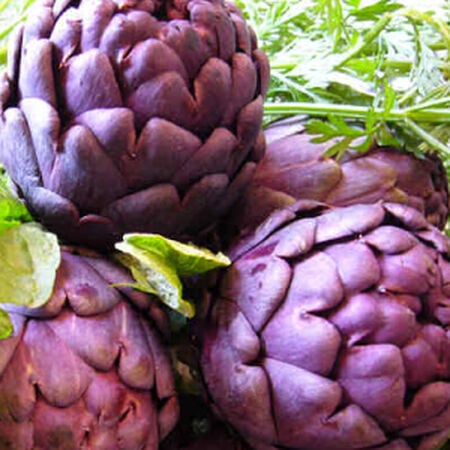Violet, Artichoke Seeds
Key Attributes
Key Attributes
Product Details
Weight
0.006Depth
0.1Height
4.5Width
3.25Plant Height
2-5'Botanical Name
Cynara scolymusSeed Type
SeedAdditional Characteristics
Fast GrowingSeeds Per Gram
22Seeds Per Pound
9,856Row Spacing
4-6'Packet
10 SeedsSow Depth
1/4"Seeds Per Ounce
616Fruit Color
VioletBreed
Open-pollinatedSun
Full SunMaturity
Early SeasonCubic Inches
1.4625Life Cycle
AnnualSow Method
TransplantPlant Spacing
24"Categories
ArtichokeGermination
5,6,7,8,9,10Days To Maturity (# Days)
85Components
Growing Instructions
![]() Learning Download: How to Grow Artichokes
Learning Download: How to Grow Artichokes
Seeing the large globe of an artichoke and imagining growing the edible beast in a garden may seem intimidating, but artichokes can be an easy and striking addition with the ability to grow almost anywhere in the United States. Depending on climate, some artichoke plants may return as perennials.
Before Planting: Artichokes require very fertile, well-drained soils with a pH of 6.5–8.0.
Planting: Artichoke seeds can be started in February in a greenhouse or under a fluorescent light, planted about 1/4-inch deep in 4-inch containers. Transport seedlings to the garden 8 to 10 weeks later, but be sure the danger of frost has passed. By then, the transplant should be nearing 10 inches in height. Plant the seedlings four feet or more apart as the plants grow large. Where winter low is above 15°F, sow seeds in fall, harvest in spring.
Watering: Artichokes need watering once a week, but can vary. If soil is heavy and holds moisture well, water less often. For warmer regions, water more frequently, but do not allow artichokes to stand in water.
Fertilizer: Artichokes require nutrient-rich soil, so be sure to fertilize with fish emulsion.
Days to Maturity: Harvest buds measuring at least three inches across while the bud is still closed. The more a bud opens, it becomes bitter, and fully open buds are inedible. (85-100 days)
Harvesting: Clip mature buds midsummer to mid-fall, depending on location.
Tips: To induce early budding time, transplant so plants receive 10 days of 45–50°F temperatures. Protect from frost at night.
Shipping Schedule
Our Seed Promise
 "Agriculture and seeds" provide the basis upon which our lives depend. We must protect this foundation as a safe and genetically stable source for future generations. For the benefit of all farmers, gardeners and consumers who want an alternative, we pledge that we do not knowingly buy or sell genetically engineered seeds or plants.
"Agriculture and seeds" provide the basis upon which our lives depend. We must protect this foundation as a safe and genetically stable source for future generations. For the benefit of all farmers, gardeners and consumers who want an alternative, we pledge that we do not knowingly buy or sell genetically engineered seeds or plants.
The mechanical transfer of genetic material outside of natural reproductive methods and between genera, families or kingdoms, poses great biological risks as well as economic, political, and cultural threats. We feel that genetically engineered varieties have been insufficiently tested prior to public release. More research and testing is necessary to further assess the potential risks of genetically engineered seeds. Further, we wish to support agricultural progress that leads to healthier soils, to genetically diverse agricultural ecosystems, and ultimately to healthy people and communities.
To learn more about the "Safe Seed Pledge" please visit www.councilforresponsiblegenetics.org.

